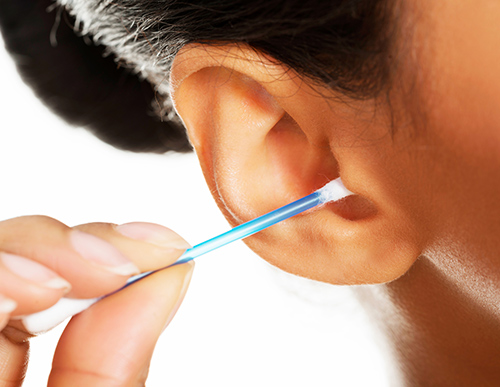
If your morning routine is too long and too hectic, we have some good news: you can cross ear cleaning with swabs right off of your list.
Ear health experts including your local hearing care professional, the American Academy of Otolaryngology-Head and Neck Surgery (AAO-HNS), the warning on your box of swabs and your grandmother agree that you should never stick anything bigger than your elbow into your ears. Take a look at these 5 reasons why ear wax deserves a better reputation:
1. Your Ears Are Self-Cleaning Miracles of Nature
Cerumen (the scientific word for ear wax) is your ears’ own cleaning solvent. It traps dirt and dust entering the ear canal, preventing it from slipping deeper down where it could get impacted and block your ear drum and dull your hearing. The ordinary daily mechanics of yawning, chewing and talking moves the dirty ear wax out of the ear canal so you don’t have to do anything except take a regular shower. Using a swab, fork, chopstick, finger, key, paintbrush or any other foreign object for ear wax removal will negate your ears’ self-cleaning efforts, pushing dirty old ear wax deeper into the canal where it can get impacted and cause hearing loss.
2. Ear Wax is Your Ears’ Custom Cleaning Solution
Sure, cerumen may look worse than overcooked beans, but your ceruminous and sebaceous glands make this special recipe for the health of your ears. In addition to effectively removing dust and crud out of your ear canal, ear wax guards your ears against bacteria, fungal infections and viruses. It’s even an effective insect repellant for your ears! It also protects and lubricates the inside of the ear canal to keep it healthy.
In fact, these glands whip up a special recipe of cholesterol, sebum, long-chain fatty acids, enzymes, alcohols, sloughed off skin cells, and other chemicals especially formulated for your personal ears—the end result is ear-protecting ear wax. Healthy cerumen is also slightly acidic—which very helpfully inhibits fungal and bacterial growth. Thanks, ear wax!
3. Bad Ear Cleaning Habits = Hearing Loss
If you’re one of the millions of people who have been using swabs to clean their ears over the years, it’s possible you’ve already suffered some level of hearing loss. That’s because you may have shoved some dirty old ear wax down your ear canal in the swabbing process, clogging your ear canal and blocking hearing. The best thing to do is schedule an appointment with your hearing care professional for a hearing checkup to determine whether or not you have impacted ear wax that might be causing some amount of hearing loss. Impacted ear wax removal should only be done in the office.
Also, there are some people who have actual ear wax problems that need to be addressed with ear wax removal—but still not with swabs. Some people’s ears make it too dry or too wet. Sometimes the chemical composition is off and it doesn’t do its job properly. Even in these cases, however, you should still shun sticking anything into your ears besides your elbow for ear wax removal or evaluation. Call your hearing care professional if you’re worried about your ear wax.
Note about hearing aids: ear wax buildup can lessen the effectiveness of your hearing aids, if you wear them. Improper hearing aid cleaning can also cause ear wax jams. So it’s very important to follow any hearing aid cleaning and gentle ear washing instructions that your hearing care professional gives you.
4. You Won’t Like These Ear Cleaning Injuries
It’s important for parents the world over to understand that ear cleaning is not necessary like brushing your teeth is! Every day, somewhere in America, 34 kids are rushed to the doctor with ear cleaning injuries. Unfortunately, these injuries sometimes cause hearing loss that impacts the child’s language and communication development. So teach your kids not to put anything in their ears except their elbows (and then giggle as they try to do it). But seriously, the most common of these ear injuries include tympanic membrane tears (torn ear drum) or other small lacerations and cuts inside of the ear canal.
We hear some of you out there thinking out loud about “ear candling”. It’s long been touted as a “natural ear wax removal” practice by many natural health food stores, but this is an ear cleaning method you should definitely avoid. Those who practice it stick a cone-shaped, hollow candle-like thing into their ear canals and set it on fire. Needless to say, thousands of people end up in the doctor’s office with ear candling injuries every year.
Important things to remember about ear candling:
- It’s been proven ineffective for ear cleaning and can actually make ear wax impaction worse.
- It causes burn injuries to the face, ears, hair, etc. – even burns that go all the way to the ear drum and middle ear.
- It’s also been known to puncture the ear drum.
So just… don’t do it!
5. Your Daily Shower Should Do the Trick
All you really need to do is take your daily shower, wash your hair and then dab your ears out with a towel. This is the safe, effective ear wax removal technique your grandmother and your hearing care professional can agree on. It gently removes just the excess ear wax that has already deposited dirt outside of your ear canal.
But listen, if not cleaning your ears makes you feel weird, or if you have any other concerns about ear wax impaction, ear injury or hearing loss, please schedule an appointment with your hearing care professional for an ear checkup today.
